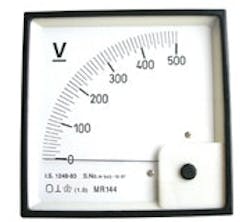Panel Meters Show Off
Ever faster and more powerful computing has pushed the evolution of big-ticket automation and control devices for years. As this data processing gets smaller and less costly, it's forcing its way into even basic components. For example, panel meters migrated in recent decades from their roots in analog dials and swing-arm meters to simple digital readout displays. However, their evolution didn't stop there.
"Panel meter technology improved over the years to become more and more capable," says Jeff Thornton, indication and control products manager at Red Lion Controls (www.redlion.net). "They do more control, retransmit analog outputs and have communication packages such as Profibus, Modbus and Ethernet that made the meters smarter. Now, because sensors don't just send one data pulse per gallon, we can use a panel meter and DIN-rail converter to do the workhorse duty of performing data conversions, displaying them and putting them on the communications loop. This gives local operators a heads-up on local temperatures or conveyor speeds that they can pass up to management."
These new advantages add to the traditional benefit that low-cost panel meters usually can be supported by maintenance and repair staff but also function as data hubs that feed HMIs and other higher-level functions.
To retain and sometimes regain some of the comforting look and feel of their former analog displays, buttons and dials, some users replace their digital panel meters with small LCDs or touchscreen versions that can be customized more easily and accommodate other languages, says Todd Christiensen, marketing director at QSI (www.qsicorp.com). "Of course, there are many LCD and touchscreen phones now, and some of these consumer trends are making their way into industry, but they need to be protected against extreme temperatures, shock and vibration," says Christensen.
Bob Mullins, QSI's industrial products manager, adds that 3.5-to-4.3-in. touchscreens now are often priced under $500, which is enabling many users to put on-screen gauges and knobs on their panels. "One small HMI can replace a lot of physical lights and buttons," explains Mullins. "They all can be viewed on that one screen and easily changed as needed. It's a natural evolution."
Besides adding higher-resolution LCDs and touchscreens, some panel meter developers are making the interface easier to read and adding other helpful hardware and software-based features. For instance, Yokogawa reports that its UTAdvanced panel meter can be used on a ¼-in. or 1/8-in. DIN-rail, display information in four languages, offer eight control algorithms, provide drag-and-drop programming and be USB-powered.
"End users who previously had to buy a temperature controller or a PID controller and a PLC now can buy one piece of equipment," says Steve Byrom, network solutions product manager at Yokogawa (www.yokogawa.com/us). UTAdvanced combines Yokogawa's 500 Series PID controller and a micro PLC with ladder logic programming.
"The joke was always that no one will be happy until panel meters work like HMIs," adds Thornton. "However, a panel meter still can't handle a lot of data like an HMI, but an HMI can't manage sensor data like a panel meter."
Despite these traditional limitations, Thornton says improved communications gives many panel meters new life because users can, for example, program the meters to change setpoints without manual intervention. Red Lion says it recently helped a chocolate manufacturer cut paper and wrap its candy bars by joining an HMI to its panel meter. "The HMI holds the recipes for specific candy bars and then downloads them to the panel meter," says Thornton. "The operators can just call up the recipe for wrapping Candy Bar No. 1 or No. 2 and push a button, and away it goes."
Though he sees that panel meters, HMIs and PLCs might one day merge as control systems are increasingly tied together, Thornton adds, "A lot of users just want a $100 panel meter without a lot of extras. For instance, they can invest in our Cub 5 1/8-in. DIN-rail panel meter and then add communication and field-programmable cards as needed without having to buy a new device."


